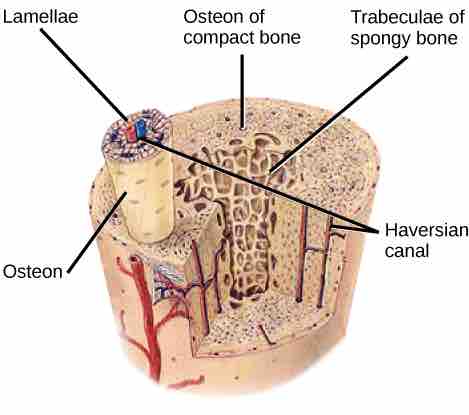Bone Tissue
Bones are considered organs because they contain various types of tissue, such as blood, connective tissue, nerves, and bone tissue. Osteocytes, the living cells of bone tissue, form the mineral matrix of bones. There are two types of bone tissue: compact and spongy.
Compact Bone Tissue
Compact bone (or cortical bone), forming the hard external layer of all bones, surrounds the medullary cavity (innermost part or bone marrow). It provides protection and strength to bones . Compact bone tissue consists of units called osteons or Haversian systems. Osteons are cylindrical structures that contain a mineral matrix and living osteocytes connected by canaliculi which transport blood. They are aligned parallel to the long axis of the bone. Each osteon consists of lamellae, layers of compact matrix that surround a central canal (the Haversian or osteonic canal), which contains the bone's blood vessels and nerve fibers. Osteons in compact bone tissue are aligned in the same direction along lines of stress, helping the bone resist bending or fracturing. Therefore, compact bone tissue is prominent in areas of bone at which stresses are applied in only a few directions.

Components of compact bone tissue
Compact bone tissue consists of osteons that are aligned parallel to the long axis of the bone and the Haversian canal that contains the bone's blood vessels and nerve fibers. The inner layer of bones consists of spongy bone tissue. The small dark ovals in the osteon represent the living osteocytes.
Spongy Bone Tissue
Compact bone tissue forms the outer layer of all bones while spongy or cancellous bone forms the inner layer of all bones. Spongy bone tissue does not contain osteons. Instead, it consists of trabeculae, which are lamellae that are arranged as rods or plates . Red bone marrow is found between the trabuculae. Blood vessels within this tissue deliver nutrients to osteocytes and remove waste. The red bone marrow of the femur and the interior of other large bones, such as the ileum, forms blood cells.
Arrangement of trabeculae in spongy bone
Trabeculae in spongy bone are arranged such that one side of the bone bears tension and the other withstands compression.
Spongy bone reduces the density of bone, allowing the ends of long bones to compress as the result of stresses applied to the bone. Spongy bone is prominent in areas of bones that are not heavily stressed or where stresses arrive from many directions . The epiphysis of a bone, such as the neck of the femur, is subject to stress from many directions. Imagine laying a heavy-framed picture flat on the floor. You could hold up one side of the picture with a toothpick if the toothpick were perpendicular to the floor and the picture. Now, drill a hole and stick the toothpick into the wall to hang up the picture. In this case, the function of the toothpick is to transmit the downward pressure of the picture to the wall. The force on the picture is straight down to the floor, but the force on the toothpick is both the picture wire pulling down and the bottom of the hole in the wall pushing up. The toothpick will break off right at the wall.
The neck of the femur is horizontal like the toothpick in the wall. The weight of the body pushes it down near the joint, but the vertical diaphysis of the femur pushes it up at the other end. The neck of the femur must be strong enough to transfer the downward force of the body weight horizontally to the vertical shaft of the femur.